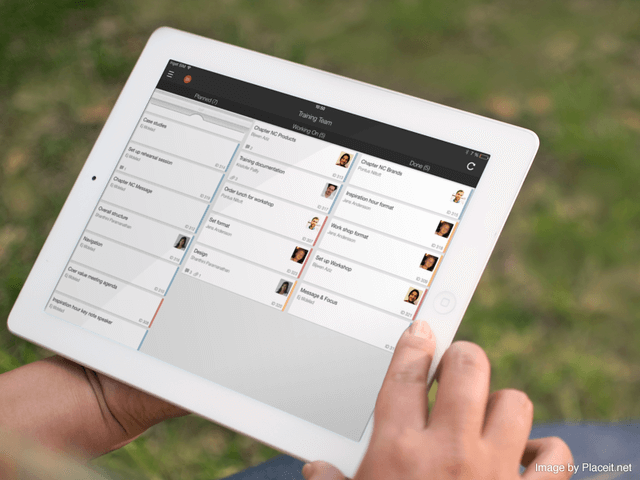
Unless you’ve recently assumed the role of accidental project manager, you’ve probably heard about the Kanban method. Praised for being simple and easy to use, Kanban has helped countless organizations manage tasks and track project workflows.
These days, Kanban has moved away from its simplistic index card design. Thanks to advancements in workplace technology, Kanban has been integrated into many project management platforms where it helps team members prioritize tasks and track the progress of their projects. As a result, organizations have been able to manage large projects more efficiently. In this post, we’re going to look at five reasons to start Kanban for your next project.
Kanban is Simple, Yet Effective
What makes the Kanban method so useful is that it’s incredibly easy to set up.
Before the days of computer software, Kanban was done with cards. Project managers would write goals and tasks on the face of the card, and based on the status of the task at hand, team members would arrange those cards into one of the following columns:
- Tasks to do
- Pågående uppgifter
- Slutförda uppgifter
These days, index cards are hardy effective at managing large multinational projects. However, the Kanban method lives on in digital project management tools, where teams collaborate online using virtual cards to assign and track the progress of various tasks. If you haven’t adopted the Kanban method in your workflow, read further to learn how it enhances your project management strategy.
1. Kanban introduces teams to Agile project management
Agile project management may have become a hot topic over the last couple of years, but for the longest time, it was the tech industry’s best-kept secret. Once organizations in other fields learned how easily Agile can be applied outside of tech, it quickly became one of the most popular project management styles across industries.
Like Kanban, the basic idea of Agile project management is simple. Instead of assigning project tasks in a linear manner, which team members must complete before moving on to the next level, Agile assigns tasks to teams (or individuals) based on their areas of expertise. As a result, multiple tasks are assigned and completed at once by various teams, rather than everyone coming together to tackle a single task.
The other key benefit of Agile management lies in the planning process. Everyone, from stakeholders all the way to team members on the ground, are involved in planning the project. In fact, the Agile approach places a lot of value in the opinions and suggestions of workers, as they’re the ones with the knowledge and expertise needed to complete the tasks at hand.
But how does this specifically relate to Kanban? Aside from being an integral part of Agile project management, Kanban acts as the platform where all project members can collaborate. Digital Kanban boards make communication between managers, workers, and stakeholders easier than ever. All parties involved can communicate and visualize workflows in real time – which is incredibly useful for large projects where you’re tracking the progress of multiple teams at once.
2. Kanban makes every workplace smarter
Project managers face a lot of pressure when it comes to managing resources and meeting deadlines. This rings especially true for managers of large organizations with long, drawn-out projects.
With the help of Kanban, you can reduce some of that pressure by managing tasks more efficiently. Instead of memos and progress reports, Kanban gives you a visual display of your project’s status, so you can see what tasks have been accomplished. The benefits of this include:
- Having a visual map of your project from start to finish, making it easier to judge progress and make changes
- Workers will see any changes to your tasks or instructions in real time
- Kanban lets you monitor multiple teams at once, helping you identify and remedy bottlenecks or road bumps in the workflow
Furthermore, Kanban tools ensure that all team members stay current with the status of the project at all times. As soon as a team begins or completes a task, its status is immediately updated on the workflow for all to see.
3. Kanban promotes real teamwork
Traditionally, project management didn’t involve much actual collaboration between managers and team members. Instead of working together to create a project plan, managers would simply delegate tasks to the workers and check in periodically to measure the progress of various tasks. Of course, all of that changed when Agile became the norm. And thanks to Kanban boards, managers and team members can actually work together to complete projects successfully.
Kanban promotes collaboration in two different, yet equally important, ways:
- Through technology: Most Kanban software comes with built-in communication tools. Here, all participants can share ideas and overcome obstacles together. Not only does this help create an open-door policy, it also boosts communication between teams and management. Because when one person asks questions or gives project updates, more people are compelled to follow suit.
- Through collaboration: As part of the Agile method, teamwork is an intrinsic part of Kanban. One of the motivating factors behind Kanban is to bring team members together so they can delegate and complete tasks more efficiently by encouraging feedback and brainstorming as a group.
For these reasons, Kanban becomes especially effective when used in large projects with bigger teams where people care freely share ideas and resources.
4. Kanban brings transparency to the workflow
If you’ve ever had to manage projects by manually entering data on spreadsheets, you know how easy it is to lose track of your overall progress. Kanban addresses this problem by providing you and your team with a visual representation of your project’s roadmap from start to finish. In a matter of seconds, you know which tasks:
- Are waiting in queue
- Are currently being worked on by one or more team members
- Have been completed
- Can’t progress until a problem is addressed
By adding Kanban to your project management toolbox, you can benefit from added transparency throughout your project. You’ll know which tasks team members are working on, what resources you have available, and how close you are to meeting target goals or deadlines.
Moreover, this transparency makes it easier to keep executives and stakeholders up to speed throughout your project, which can make evaluations and project meetings go much more smoothly.
Kanban brings project success
When paired with project management software, Kanban helps to minimize inefficiencies and add transparency to your workflow, no matter your project size. That way, you can spend more time collaborating with your team, rather than struggling to track the progress of your various tasks.





